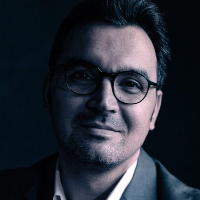The Effect of Digital Painting on the Works of the New Generation of Artists of the Islamic Revolution by Focusing on Walter Benjamin's Views(Case Study: Hassan Rouholamin, mikael barati, and Danial Farrokh)
Today's world has witnessed many changes in the field of communication and technology. Many areas of contemporary human life have also been affected by these developments. Naturally, the field of art, as one of the deepest and most original aspects of human life, has not been far from these changes. Therefore, today we must pay attention to the impact of digital technologies and the new generation of virtual media on various artistic currents and forms. Painting of the Islamic Revolution is one of these artistic forms. In this research, the painting of the Islamic Revolution refers to works that have dealt with the concerns, events, themes, attitudes, beliefs and identity elements of the Islamic Revolution in the period of the Islamic Revolution. These works - in addition to the role of intellectual issues in the formation of their original identity - have been able to achieve certain stylistic components. The present article intends to examine these effects on a branch of contemporary Iranian art called revolutionary painting, focusing on the works of the new generation of digital artists. This article tries to answer the question that how new generation of painters of the Islamic Revolution have used digital painting techniques in their works? And what are the effects of using digital painting techniques on their work? The theoretical framework of this article is the views of Walter Benjamin, one of the thinkers of the Frankfurt School, in his article "Art in the Age of Mechanical Reproduction" and his critical view of traditional art and the challenges it faces in expanding industrial and technological achievements. The type of research is fundamental-theoretical and the method is descriptive-analytical and the method of gathering information is documentary and observational. The data collection tool is filing and observing the works and also the new scanning tool and the method of analyzing is qualitative. The young artists whose work this article examines are Hassan Rouhalamin, Daniel Farrokh, and Mikael Barati. This article examines the characteristics of digital painting, from Benjamin's critical point of view, to the challenges of using digital painting techniques in the works of the new generation of painters of the Islamic Revolution and concludes that the artists of the new generation of revolutionary painting have been able to overcome the new situation and they use digital painting in order to achieve their artistic and ideal goals. Some of their goals are more direct communication with social issues, quick reaction to events, Interaction with a wider audience, reducing production costs, eliminating intermediaries for displaying and publishing works, removal of artists' signatures from the work, focusing and increasing emotion, and using different artistic techniques. Therefore, this group of artists have been able to take advantage of the new situation and conditions of digital painting and use it to achieve their artistic goals. Therefore, according to Walter Benjamin's critical views, the effect of digital painting on these works can be considered in line with the goals and policies of their creators and can be evaluated as generally positive.
- حق عضویت دریافتی صرف حمایت از نشریات عضو و نگهداری، تکمیل و توسعه مگیران میشود.
- پرداخت حق اشتراک و دانلود مقالات اجازه بازنشر آن در سایر رسانههای چاپی و دیجیتال را به کاربر نمیدهد.




